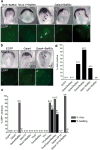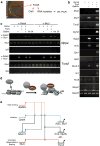Directed transdifferentiation of mouse mesoderm to heart tissue by defined factors
- PMID: 19396158
- PMCID: PMC2728356
- DOI: 10.1038/nature08039
Directed transdifferentiation of mouse mesoderm to heart tissue by defined factors
Abstract
Heart disease is the leading cause of mortality and morbidity in the western world. The heart has little regenerative capacity after damage, leading to much interest in understanding the factors required to produce new cardiac myocytes. Despite a robust understanding of the molecular networks regulating cardiac differentiation, no single transcription factor or combination of factors has been shown to activate the cardiac gene program de novo in mammalian cells or tissues. Here we define the minimal requirements for transdifferentiation of mouse mesoderm to cardiac myocytes. We show that two cardiac transcription factors, Gata4 and Tbx5, and a cardiac-specific subunit of BAF chromatin-remodelling complexes, Baf60c (also called Smarcd3), can direct ectopic differentiation of mouse mesoderm into beating cardiomyocytes, including the normally non-cardiogenic posterior mesoderm and the extraembryonic mesoderm of the amnion. Gata4 with Baf60c initiated ectopic cardiac gene expression. Addition of Tbx5 allowed differentiation into contracting cardiomyocytes and repression of non-cardiac mesodermal genes. Baf60c was essential for the ectopic cardiogenic activity of Gata4 and Tbx5, partly by permitting binding of Gata4 to cardiac genes, indicating a novel instructive role for BAF complexes in tissue-specific regulation. The combined function of these factors establishes a robust mechanism for controlling cellular differentiation, and may allow reprogramming of new cardiomyocytes for regenerative purposes.
Figures




Comment in
-
Developmental biology: The early heart remodelled.Nature. 2009 Jun 4;459(7247):654-5. doi: 10.1038/459654a. Nature. 2009. PMID: 19494907 Free PMC article.
References
-
- Srivastava D. Making or breaking the heart: from lineage determination to morphogenesis. Cell. 2006;126:1037–1048. - PubMed
-
- Lickert H, Takeuchi JK, von Both I, et al. Baf60c is essential for function of BAF chromatin remodelling complexes in heart development. Nature. 2004;432:107–112. - PubMed
-
- Simone C, Forcales SV, Hill DA, et al. p38 pathway targets SWI-SNF chromatin-remodeling complex to muscle-specific loci. Nat Genet. 2004;36:738–743. - PubMed
Publication types
MeSH terms
Substances
Grants and funding
LinkOut - more resources
Full Text Sources
Other Literature Sources

